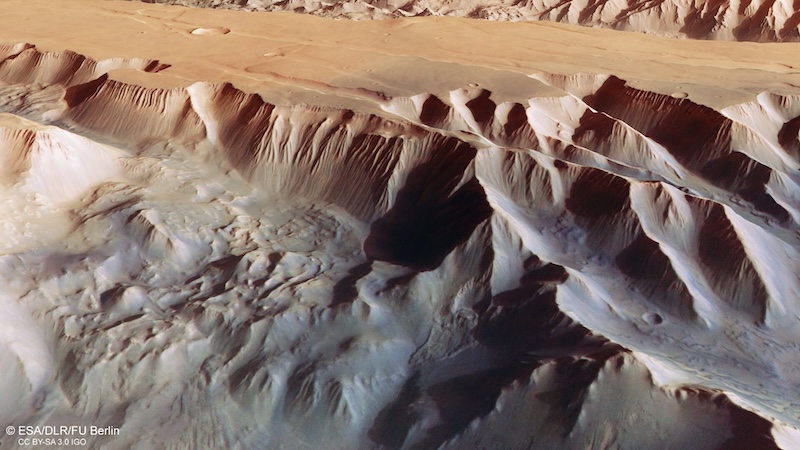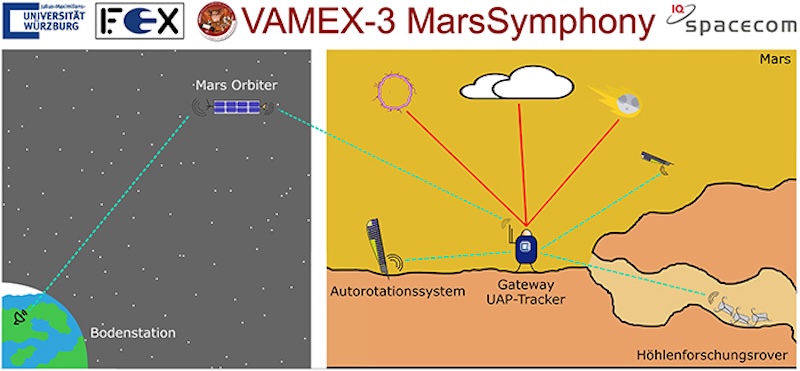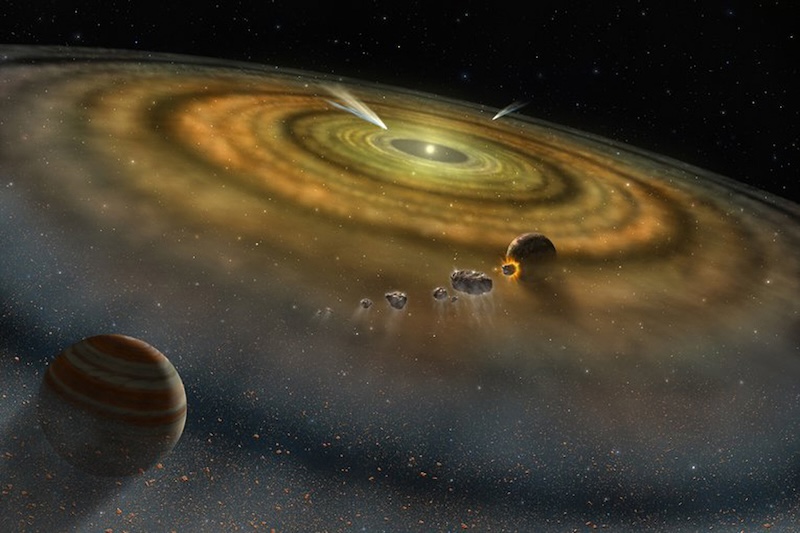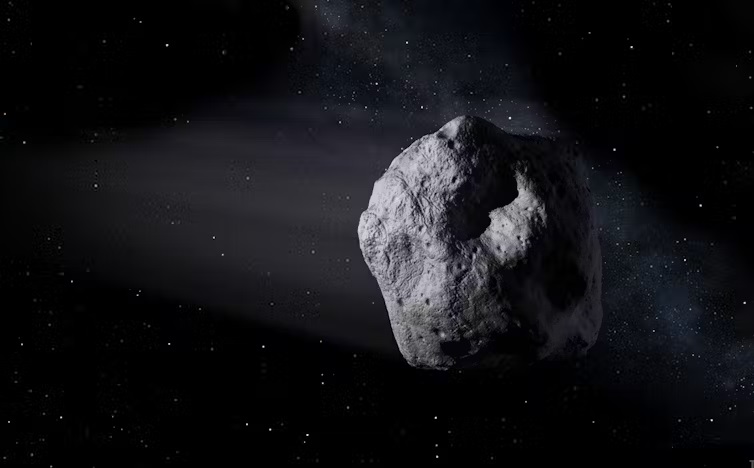*

- Valles Marineris is the Grand Canyon of Mars. It’s the largest canyon system in the solar system, 10 times longer, 20 times wider, and five times deeper than the Grand Canyon. If it were on Earth, it would stretch from the U.S. East to West coasts.
- A swarm of robotic drones has been proposed to drive, walk and fly around the canyon. They could also explore caves in the canyon and look for traces of water.
- A UFO/UAP camera stationed on the ground would also monitor the sky for clouds, meteors, lightning … or other “unusual activity.”
Exploring Mars’ Grand Canyon
The largest canyon in the solar system is on Mars. Valles Marineris is the Grand Canyon of Mars and dwarfs its counterpart on Earth. Orbiting spacecraft have photographed it in great detail, but no mission has yet visited it on the ground. But that might be about to change. The German Space Agency at the German Aerospace Centre (DLR) in Bonn, Germany, is developing an ambitious mission concept called Valles Marineris Explorer, or VaMEx. It involves a swarm of robotic drones that can drive, walk and fly, the researchers said on September 10, 2024. It would explore the sprawling canyon and caves within it.
Interestingly, the mission would also include a UAP camera, named for Unidentified Anomalous Phenomena. That term has, in recent years, replaced the acronym UFO in government-speak of several nations. It’s been used to describe any unusual phenomena seen in Earth’s atmosphere, or oceans. The UAP camera would be stationary. It would watch Mars’ sky continuously. It would keep an eye out for anything unusual. More about it below.
A robotic swarm for exploring Mars’ Grand Canyon
VaMEx consists of a complex swarm of robotic drones that can both move on the ground and fly in the air. The drones would communicate both with each other and a central gateway station on the surface.
In addition, the drones would look for traces of water that could help support life in protected niches. Indeed, orbiting spacecraft have photographed foggy mists in the canyon. The search for water also includes caves within the canyon. If there is any existing life on Mars today – even if just microbial – the environment deep inside caves would be a good place to look. They might have enough traces of water and would offer protection from the harsh radiation that hits Mars’ surface from the sun. Plus, of course, caves provide a natural doorway to explore geologic formations beneath the surface. What might we find?
Complex communications and drone network
There is a sub-project of VaMEx called VaMEx3-MarsSymphony, or just MarsSymphony. It is developing the complex communications system needed for the swarm. Hakan Kayal at the University of Würzburg is the project leader. He said:
We have given our sub-project the name ‘VaMEx3-MarsSymphony’ because the aim is to make the individual elements of the robot swarm play together harmoniously like an orchestra.
The swarm concept includes the stationary gateway, or command center, to aid communications for the drones. It would also facilitate communication with each other and with orbiting spacecraft and Earth. But sometimes the drones won’t be able to communicate directly with the gateway. For example, when they’re inside caves. To work around this, there would also be repeater stations on the ground. They can pass along recorded images and other data from the drone in the cave to the gateway.

Spreading ‘seeds’ on Mars
Another element of the swarm concept is autorotation bodies. These are small “craft” that are simply dropped from the air and gently glide to the ground. They kind of look like maple seeds with their elongated bodies. They also spin as they glide downward, with the aid of a wing. And like seeds being dispersed, they can be distributed over a wide area. They gather data as they fall to the Martian surface.
In addition, they can function as sensors, repeaters and navigation networks. Clemens Riegler is the project manager of MarsSymphony. He said:
It’s great to see that DLR is recognizing this work and that it has now become part of a project to explore Mars!
UAP camera to scan Martian skies
There is another unique element to the VaMEx mission, something else never done before. The researchers want to include a UAP camera, or celestial camera, on the stationary gateway. UAP – Unidentified Anomalous Phenomena – is the term now used by governments and the military for what used to be called UFOs. It’s for sightings of unusual objects or other phenomena in Earth’s atmosphere (and now including the ocean or space as well).
In the case of VaMEx, the UAP camera would watch the Martian sky continuously. That would be its only function. While not specifically looking for alien spacecraft, it would monitor clouds, meteors, lightning or any other unusual or short-lived phenomena. No other lander or rover mission has done that before. They have coincidentally imaged the Martian sky and even the moons Phobos and Deimos, for example. But the sole purpose of this camera would be to stare at the sky. As Kayal said:
All previous Mars missions have focused on the surface of the planet, but we want to look upward for the first time.

What is the UAP camera looking for?
You can also read a more detailed interview with Hakan Kayal where he explains how the UAP camera would work. As Kayal told researcher Andreas Müller in Germany:
We still don’t know what UFOs and UAPs are. Mars and Earth are very similar in many ways, from geology to meteorology. If there are UAPs on Earth, they could also be visible in the Martian sky. Another advantage of such a detection would be that on Mars we could at least rule out known terrestrial triggers of many classic UFO/UAP sightings such as birds, insects, balloons and aeroplanes etc. as explanations for any UAPs detected from the outset. The number of terrestrial satellites and probes on and around Mars is also still manageable and their flight and orbital paths are known, predictable and easy to check.
However, we are not looking for little green men on Mars, but anomalies that could indicate new events or characteristics. The chances of this are small, but such a detection on Mars would be a sensation and would provide us with data that often stand in the way of clarifying these phenomena with terrestrial systems.
Bottom line: Researchers in Germany are developing a mission for exploring Mars’ Grand Canyon, Valles Marineris. It would involve a swarm of robotic drones.
Via University of Würzburg
Read more: See Mars’ Grand Canyon in stunning new photos
Read more: Scientists find water in Mars’ Grand Canyon





No comments! Be the first commenter?